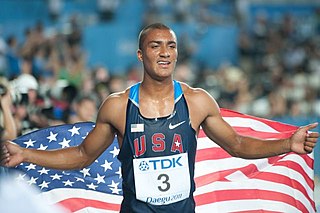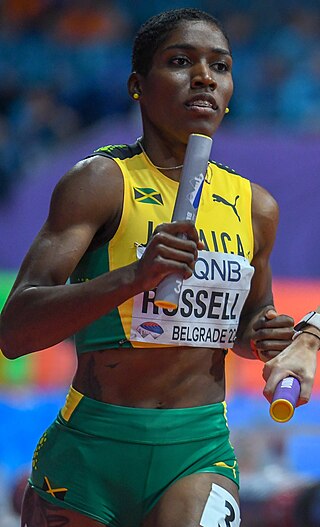Related Research Articles

The long jump is a track and field event in which athletes combine speed, strength and agility in an attempt to leap as far as possible from a takeoff point. Along with the triple jump, the two events that measure jumping for distance as a group are referred to as the "horizontal jumps". This event has a history in the ancient Olympic Games and has been a modern Olympic event for men since the first Olympics in 1896 and for women since 1948.

The decathlon is a combined event in athletics consisting of 10 track and field events. The word "decathlon" was formed, in analogy to the word "pentathlon", from Greek δέκα and ἄθλος. Events are held over two consecutive days and the winners are determined by the combined performance in all. Performance is judged on a points system in each event, not by the position achieved. The decathlon is contested mainly by male athletes, while female athletes typically compete in the heptathlon.

Paavo Ilmari Yrjölä, also known as the Bear of Hämeenkyrö, was a Finnish track and field athlete who won the gold medal in the decathlon at the 1928 Summer Olympics. He also competed in shot put and high jump at the same Games, and in decathlon in 1924 and 1932, but less successfully.

The 100 metres, or 100-meter dash, is a sprint race in track and field competitions. The shortest common outdoor running distance, the 100-meter (109.36 yd) dash is one of the most popular and prestigious events in the sport of athletics. It has been contested at the Summer Olympics since 1896 for men and since 1928 for women. The inaugural World Championships were in 1983.

Heike Gabriela Drechsler is a German former track and field athlete who represented East Germany and later Germany. One of the most successful long jumpers of all-time, she is a former world record holder and ranks third on the all-time list with her legal best of 7.48 metres in 1988. Her marginally wind-assisted jump of 7.63 metres (+2.1) in 1992 at altitude in Sestriere, is still the furthest a woman has ever long jumped. She is the only woman who has won two Olympic gold medals in the long jump, winning in 1992 and 2000.
The men's 100 metres was the shortest of the men's track races in the Athletics at the 1964 Summer Olympics program in Tokyo, Japan. It was held at the Olympic Stadium on 14 and 15 October 1964. 76 athletes from 49 nations entered, with 3 not starting in the first round. Nations were limited to three athletes each, per rules in force since the 1930 Olympic Congress. The first two rounds were held on 14 October, with the semifinals and the final on the following day.

The 110 metres hurdles, or 110-metre hurdles, is a hurdling track and field event for men. It is included in the athletics programme at the Summer Olympic Games. The female counterpart is the 100 metres hurdles. As part of a racing event, ten hurdles of 42 inches (106.7 cm) in height are evenly spaced along a straight course of 110 metres. They are positioned so that they will fall over if bumped into by the runner. Fallen hurdles do not carry a fixed time penalty for the runners, but they have a significant pull-over weight which slows down the run. Like the 100 metres sprint, the 110 metres hurdles begins in the starting blocks.
The 10-second barrier is the physical and psychological barrier of completing the 100 metres sprint in under ten seconds. The achievement is traditionally regarded as the hallmark of a world-class male sprinter. Its significance has become less important since the late 1990s, as an increasing number of runners have surpassed the ten seconds mark. The current men's world record holder is Usain Bolt, who ran a 9.58 at the 2009 IAAF World Championship competition.

Ashton James Eaton is a retired American decathlete and two-time Olympic champion, who holds the world record in the indoor heptathlon event. Eaton was the second decathlete to break the 9,000-point barrier in the decathlon, with 9,039 points, a score he bettered on August 29, 2015, when he beat his own world record with a score of 9,045 points, and remains the only person to exceed 9000 points twice. His world record was broken by Frenchman Kevin Mayer on September 16, 2018, with a total of 9,126 points, who became the third man to pass the 9,000-point barrier.
Yvette Lewis is a German-born American track and field athlete who competes for Panama in the 100 meter hurdles and the triple jump. She represented the United States in international competition until October 2012 when switched to compete for Panama. Her best time in the hurdles is 12.76 seconds while her best triple jump is 13.84 meters. She won the gold medal in the hurdles at the 2011 Pan American Games

Karsten Warholm is a Norwegian sprinter who competes in the 400 metres and 400 m hurdles. He is the 2020 Tokyo Olympic champion, a three-time world champion and the world record holder in the latter event.

Trayvon Jaquez Bromell is an American professional track and field athlete specializing in sprinting events. He won bronze medals in the 100 meters at the 2015 and 2022 World Championships. Bromell was the 2016 World indoor 60 meters champion, and competed for the United States at the 2016 Rio and 2020 Tokyo Olympics. He was the first junior to break the 10-second barrier in the 100 meters with a time of 9.97 seconds, the former junior world record.
Adolphus "Dolly" Jones[nb] is a Kittitian and Nevisian track and field athlete and soccer player.

Combined events at the Summer Olympics have been contested in several formats at the multi-sport event. There are two combined track and field events in the current Olympic athletics programme: a men's decathlon and a women's heptathlon.

Janieve Russell is a Jamaican track and field athlete who competes mainly in the 400 metres hurdles and the 400 metres sprint. She won an Olympic bronze medal in the 4 × 400 m relay in Tokyo 2021, where she also finished fourth in the 400m hurdles final in a personal best of 53.08 secs. She is a four-time Commonwealth Games gold medallist, winning the 400m hurdles title in 2018 and 2022, and the 4 × 400 m relay in 2014 and 2018. She has also won two relay silvers at the World Championships and a relay gold at the World Indoor Championships.

The 2002 USA Outdoor Track and Field Championships was organised by USA Track & Field and held from June 21 to 23 at the Cobb Track & Angell Field in Palo Alto, California. The three-day competition served as the national championships in track and field for the United States. The same facility would host this meet the following year, but this was the last year to use the three day format as the four-day format was adopted in 2003. The combined track and field events were contested at Edwards Stadium in Berkeley, California in the two days preceding the start of the main programme.

Oluwatobiloba Ayomide "Tobi" Amusan is a Nigerian track and field athlete who specialises in the 100 metres hurdles and also competes as a sprinter. Amusan is the current world record holder in the 100 metres hurdles with a time of 12.12 seconds which she set at the 2022 women's 100 metres hurdles semi final in Eugene Oregon. She is the current Commonwealth and African champion in the 100 m hurdles, as well as the meet record holder in those two competitions. Amusan became the first ever Nigerian world champion and world record holder in an athletics event when she won the 2022 World Championships 100 m hurdles gold medal, setting the current world record of 12.12 seconds (+0.9 m/s) in the semi-final, followed up by a 12.06 seconds (+2.5 m/s) in the final. She won back-to-back Commonwealth and African titles in 2018 and 2022 in the 100 m hurdles and is also a two-time African Games champion in the event. She is also the current Diamond league champion in the 100 metres hurdles having won the final in 12.33 seconds (+1.8 m/s) achieving a winning streak in 2021, 2022 and 2023.

The Polish Athletics Championships is an annual outdoor track and field competition organised by the Polish Athletic Association (PZLA), which serves as the Polish national championship for the sport. It is typically held as a three-day event in the Polish summer, ranging from late June to early August. The venue of the championships changes annually.
The World Athletics Rankings are an individual athlete ranking system for the sport of athletics, managed by World Athletics. It is used to establish the number one athlete within an athletics event and to partially determine qualification into the World Athletics Championships and the athletics at the Summer Olympics. The rankings are published weekly by World Athletics on Wednesday. WA President Sebastian Coe said the goal of this system is so athletes and fans "have a clear understanding of the hierarchy of competitions from national through to area and up to global events, allowing them to follow a logical season-long path to the pinnacle of athletics' top two competitions".

The women's 100 metres hurdles at the 2022 World Athletics Championships was held at the Hayward Field in Eugene on 23 and 24 July 2022. It was won by Tobi Amusan. Amusan set a world record of 12.12 seconds in the semi-final. She ran 12.06 to win the final, but that was not a world record because it was wind assisted.
References
- ↑ "Rule 260.14(c) of IAAF Competition Rules 2016-2017" . Retrieved July 29, 2016.
- ↑ "Rules, Terms and Abbreviations".
- ↑ "Archived copy" (PDF). Archived from the original (PDF) on 2013-06-15. Retrieved 2016-04-13.
{{cite web}}: CS1 maint: archived copy as title (link) - 1 2 3 Commonwealth All-Time Lists (Men) – GBR Athletics
- ↑ "Men's non-legal 100m" . Retrieved 28 August 2015.
- ↑ Carles Baronet (18 May 2013). "TRACKINSUN Athletics (Track and Field) Results -Athletisme Resultats – Leichtathletik Ergebnisse -". trackinsun.blogspot.com.es. Retrieved August 9, 2015.
- ↑ All-time men's best 200m - wind-assisted – The Track and Field all-time Performances Homepage
- ↑ "Michael Johnson" . Retrieved 28 August 2015.
- ↑ World Record Progression - 200 m men – The Athletics Site
- ↑ All-time men's best 110m hurdles - wind-assisted marks – The Track and Field all-time Performances Homepage
- 1 2 World Record Progression - 100 m. hurdles women – The Athletics Site
- 1 2 All-time women's best 100m hurdles - wind-assisted – The Track and Field all-time Performances Homepage
- ↑ "Amusan wins world 100m hurdles title after breaking world record in semis | REPORT | WCH 22 | World Athletics".
- ↑ All-time men's best triple jump - wind-assisted marks – The Track and Field all-time Performances Homepage
- ↑ All-time women's best triple jump - wind-assisted jumps – The Track and Field all-time Performances Homepage
- ↑ Biscayart, Eduardo (10 June 2007). "14.57 Area Triple Jump Record for Costa as South American Champs finish". IAAF.org. Retrieved 2007-09-05.
- ↑ TRACK AND FIELD; Pedroso's World Mark In Long Jump in Doubt, New York Times, August 4, 1995
- ↑ IWAS World Games 2009 - Athletics Results
- ↑ All-time women's best long jump - wind-assisted jumps – The Track and Field all-time Performances Homepage
- ↑ All-time men's best decathlon - wind-assisted series – The Track and Field all-time Performances Homepage
- ↑ World Record Progression - decathlon men – The Athletics Site
- ↑ World Junior Records and Best Performances – GBR Athletics
- ↑ All-time women's best heptathlon - wind-assisted serie – The Track and Field all-time Performances Homepage
- ↑ Hollobaugh, Jeff (2024-04-17). "Oklahoma Throws — Alekna Rides Wind To World Record". Track & Field News. Retrieved 2024-05-25.